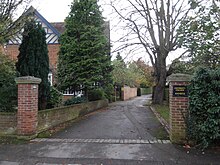Staverton Road

Staverton Road is a residential road in North Oxford, England.
Location[edit]
The road runs east–west with a gentle curve halfway along.[1] At the western end of the road is a junction with Woodstock Road (A4144) and at the eastern end is a junction with Banbury Road (A4165), the two major arterial roads out of Oxford to the north. Opposite slightly to the north at the western end is Frenchay Road. Opposite slightly to the south at the eastern end is Belbroughton Road. Parallel to the south is Rawlinson Road and to the north is Lathbury Road. It forms the approximate northern boundary of the original North Oxford development by St John's College, Oxford, along with Frenchay Road to the west and Marston Ferry Road to the east.[2]
Stavertonia[edit]


"Stavertonia" (aka Stavs and formerly Stavers), or the University College Annexe, a student accommodation complex of buildings for University College, Oxford, is located south of the road,[3] largely built from 1967.[4] The new buildings were designed by the University College alumnus Sir Philip Dowson of Arup Associates.[5] Staverton House, at 104 Woodstock Road close to Staverton Road, was bought by University College in 1953 and converted into flats.[6] Lord Beveridge (1878–1963), Master of University College from 1937–45, rented one of the flats for a while. The site includes Redcliffe-Maud House (formerly 100A Woodstock Road, built in the garden of 100 Woodstock Road), named after a former Master of University College at the time of the development of Stavertonia, Lord Redcliffe-Maud.
As of 2022[update], the Stavertonia site is being further extended and developed to become Univ North (formally University College, North Oxford[7]), stretching all the way to Banbury Road, expanding the existing 12,000 m2 site by 8,000 m2.[8]
Trinity College, Oxford has an annexe on the north corner of Staverton Road with Woodstock Road, providing accommodation for over 70 members of the college.[9] It was built in 1979 to a design by the architect Simon Shew of Grey and Baynes.[10]
Residents[edit]


The Danish-Irish astronomer John Louis Emil Dreyer (1852–1926) lived at 14 Staverton Road from 30 September 1916 onwards with his wife Kate.[11] While in Oxford, he worked on his 15-volume edited collection of the works of the Danish astronomer Tycho Brahe.[12] On 14 September 1926, Dreyer died at his home in Staverton Road.
England's first woman barrister and tutor at St Anne's College, Ivy Williams, lived at 30 Staverton Road until her death in 1966.[citation needed]
The theologian and bishop within the Eastern Orthodox Church, Kallistos Ware (born Timothy Ware, 1934), lived with his parents at 15 Staverton Road.[13]
Other residents include the ecological economist Stanislav Edward Shmelev,[14] Sir William D. M. Paton FRS (1917–1993), winner of the Gairdner Foundation International Award in 1959 and Professor of Pharmacology at the University of Oxford, and the solid-state physicist H. M. Rosenberg.[15]
The fictional character George Papadimitriou called a meeting of the Oakley Street resistance group at 28 Staverton Road in Philip Pullman’s The Book of Dust, Volume One, "La Belle Sauvage", chapter 13.[16]
References[edit]
- ^ Symonds, Ann Spokes (1997). "Buildings and Gardens". The Changing Faces of North Oxford. Vol. Book One. Robert Boyd Publications. p. 11. ISBN 1 899536 25 6.
- ^ Hibbert, Christopher, ed. (1988). "North Oxford". The Encyclopaedia of Oxford. Macmillan. pp. 282–284. ISBN 0-333-39917-X.
- ^ a b "A short history of Stavertonia". University College, Oxford. Retrieved 6 April 2022.
- ^ Harrison, Brian, ed. (1994). The History of the University of Oxford. Vol. VIII: The Twentieth Century. Oxford University Press. p. 863. ISBN 978-0198229742.
- ^ "Sir Philip Dowson, Architect of "Stavs"". University College, Oxford. Retrieved 6 April 2022.
- ^ Symonds, Ann Spokes (1998). "People". The Changing Faces of North Oxford. Vol. Book Two. Robert Boyd Publications. p. 126. ISBN 1 899536 33 7.
- ^ "University College, North Oxford". University College, Oxford. 11 June 2020. Retrieved 6 April 2022.
- ^ "Univ North: vital statistics". University College, Oxford. 2021. Retrieved 6 April 2022.
- ^ Symonds, Ann Spokes (1998). "College and Schools". The Changing Faces of North Oxford. Vol. Book Two. Robert Boyd Publications. p. 55. ISBN 1 899536 33 7.
- ^ Smith, Andrew (11 April 2008). "College honours top architect". Oxford Mail. Retrieved 6 April 2022.
- ^ Steinicke, Wolfgang (2010). Observing and Cataloguing Nebulae and Star Clusters: From Herschel to Dreyer's New General Catalogue. Cambridge University Press. p. 229. ISBN 978-0521192675.
- ^ Hughes, Stefan (2012). Catchers of the Light: The Astrophotographers' Family History. Google Books. p. 112. ISBN 978-1620509616.
- ^ Behr, John; Louth, Andrew; Conomos, Dimitri E., eds. (2003). Abba: The Tradition of Orthodoxy in the West : Festschrift for Bishop Kallistos (Ware) of Diokleia. St Vladimir's Seminary Press. p. 18. ISBN 978-0881412482.
- ^ Shmelev, Stanislav E. (2011). Ecological Economics: Sustainability in Practice. Springer. ISBN 978-9400719712.
- ^ "Staverton Road". Kelly's Directory of Oxford. Kelly's Directories. 1976. pp. 453–454.
- ^ "La Belle Sauvage: The Book of Dust Volume One". pullman.davidficklingbooks.com. David Fickling Books. 19 October 2017. Retrieved 6 April 2022.
